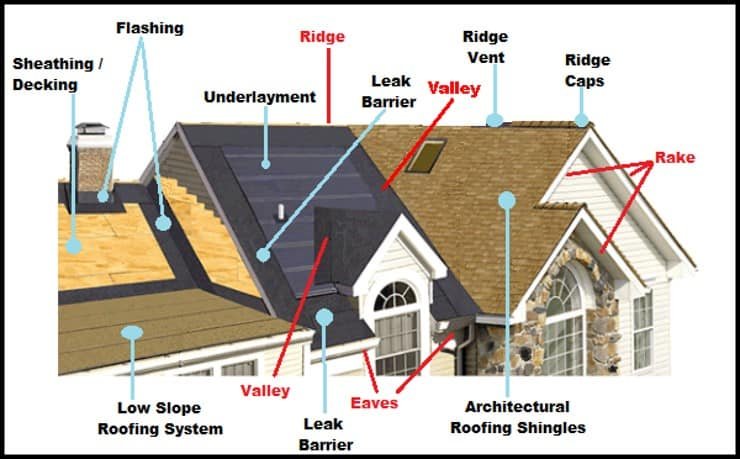
18 Roofing terms you should know.
Curious about what all the different parts of your roof are called? Contractors confusing you with all this jargon? Down below are the most common parts of your roof and what they are named.
Having basic knowledge of these components is going to help you with knowing what to look at when a contractor is pointing things out. Or if you’re doing some DIY, you know what to ask for at the supply store.
Terminology
- Square: 1 square = 100 Sq. Ft. 3 bundles of shingles = 1 square.
- Decking/ Sheathing: Plywood or OSB sheets that sit on top of the house trusses.
- Eave Edge: The lowest part of your roof. Where the gutters go.
- Rake Edge: Where 2 slopes come together and make an upside down ‘V’.
- Drip Edge: Flashing that goes on your rakes (sometimes eaves as well). Has a 1″ lip on it that allows shingles to hang out a little to avoid water getting into the fascia.
- Gutter Apron: Flashing that goes on the eaves. Sits on top of the gutters.
- Ice and Water Shield: Self adhering membrane. Goes on all the eaves, valleys, and where a slope meets a wall. On the eaves it is coded to go past 2 Ft. from the interior wall.
- Synthetic Underlayment: Underlayment that covers the rest of the roof area. Anywhere there isn’t ice and water shield at.
- Valley: Where 2 slopes come together.
- Ridge: Top of the roof area, where 2 slopes come together at the peak.
- Turtle vent: Box vent that provides ventilation allowing hot air from the attic to escape.
- Ridge Vent: Ventilation all along the ridge area. Allows better air ventilation compared to turtle vents.
- Penetrations: Anything that goes through the roof. Like Skylights, chimneys, turtle vents, pipe boots, etc.
- Starter Shingle: Special shingle that goes along the eaves and rakes to allow the actual shingle to adhere better.
- Ridge Cap: Special cap shingle that goes along the entire ridge area to water tight the home.
- Slope: A section of the roof area.
- Hip: When 2 sections of a roof come together on the outside end. The opposite of a valley.
- Step Flashing: Flashing that is used when a roof slope meets a wall. Prevents water from entering the home.
Those are the parts of the roof that you should know about and their use. Now next time you’re doing some DIY, you know what to ask for. And also now you know what to look for when a contractor is point things out on your roof.
At Pro Works Roofing we help homeowners through the whole process, answering any questions you have.
612-434-8791
651-492-5003
office@proworksroofing.com
